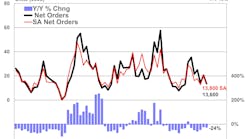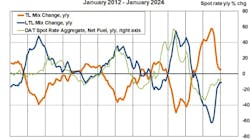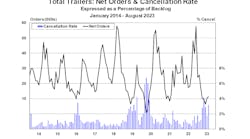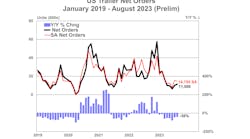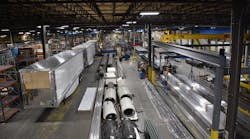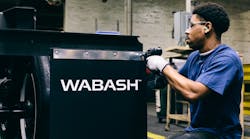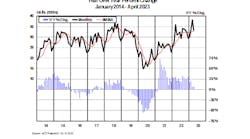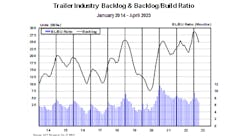THE shortage of human resources—specifically the shortage of drivers—is the most significant factor likely to shape transportation and logistics in the future.
“The driver shortage is projected to be magnified over time,” said John G Larkin, managing director of Stifel Transportation & Logistics Equity Research. “With fewer Americans considering blue-collar options, where will our truck drivers come from?
“Automated production, near shoring, and insourcing will only increase the amount of domestic freight to be moved. Are there any potential solutions to the worsening driver shortage that haven’t already been tried? Forward-looking projections show a gap in the growth of driver supply and demand, validating the concern over the shortage. Efforts to counterbalance a driver shortage need to look at increasing the driver pool to keep up with growing demand, not simply preventing it from shrinking.
“The driver shortage is a collection of impacts from multiple factors, rendering a solution more challenging to identify. The average life expectancy of a trucker is 61, while that of the general public is 77. Increasing pay may help the supply some but it is not a solution to the true problem.”
The rest of the top 10 biggest issues:
• Demographics of modern America.
“The American population is aging rapidly, and fertility is projected to be at near-term lows. The size of the American workforce has been on a steady decline over the last decade, requiring each individual to be more productive to sustain a growing population and economy. Baby Boomers are nearing retirement, while their more youthful counterparts are not sufficient in number to replace the boomers one for one.
“Most millennials are college graduates and opting for white-collar work, with fewer considering blue-collar work.
Younger generations are growing at a much slower rate than elders; the working age proportion is shrinking. An aging population is a direct result of declining fertility rates, and improved healthcare. This is resulting in a very high portion of elders in society. Of the declining number of people working, less and less of them are moving into traditional blue-collar careers.
“The white-collar workforce has increased from 25% of employment in 1920 to over 70% in 2010, but each individual is consuming more and more tons of freight.”
• From goods and products to services.
“During the last half century, our level of education has positioned us away from goods production and into services. An increasing number and tonnage of goods are now being produced domestically despite fewer people working in production, a testament to our engineering ability. As the services sector continues to take an ever- increasing portion of our domestic GDP and as production is increasingly automated, opportunities for production-related work are on the wane.
“Despite fewer production jobs, transportation and logistics demand will grow thanks to automation, 3-D printing, near-shoring, et cetera. American industry is extremely efficient, utilizing automation to increase output without requiring incremental head count. Automated production is part of the reason why American GDP growth is diverging from the health of the manufacturing and production blue-collar job environment.
“Service industries are increasingly dominating our GDP, both of which have followed steady trends since the 1950s. Services as a percent of GDP has increased from just under 50% in 1950 to 68.7% in 2010, while over the same period of time goods producers have been halved.”
• De-globalization of production.
“It is becoming more common for economies to source good locally, as competition in international markets level. Due to the balancing of the cost of production globally, companies are now focusing on locating production closer to demand. As unit labor costs increase overseas, and US energy costs drop, and as automated production evolves, we will begin to move back closer to regional models seen previously. America, as the world’s largest importer, has the greatest amount of domestic production to gain from this trend of regionalization, again challenging our ability to move goods.
“Since 2008 regions have been moving to become more self-sufficient, trading less relative to total GDP. Production companies are looking to locate more operations in North America, citing logistics advantages. As China’s total cost advantage diminishes, North American firms are increasingly moving manufacturing closer to their consumer base.”
• Urbanization and migration in America.
“The American population is becoming more densely populated, and migrating toward areas of job growth and retirement offering. Already, half of the population lives in very densely populated areas. As the urbanized population grows, transportation and logistics networks will need to rapidly adapt. Recently the populace has been migrating to areas of highest job growth or areas offering an attractive retirement. With demand following the migration of Americans, the transportation network needs to shift to fulfill these needs. Population density continues to rise as cities grow upward instead of outward, requiring a very different standard and level of infrastructure support.”
• E-commerce and omni-channel fulfillment.
“The consumer-facing model is changing from a single channel brick-and-mortar model to a multifaceted offering system. Amazon has redefined the supply chain around e-commerce. Brick-and-mortar store chains are busily implementing omni-channel strategies to compete. As e-commerce grows, supply-chain participants must adapt; fewer dedicated and private fleets, more last-mile delivery. E-commerce is fundamentally changing the customer experience, with integrated brands, and purchasing channels. As e-commerce expands, and population density polarizes in cities, fulfillment centers are increasingly located in the urban core.”
• Continuous optimization.
“Optimization methods have worked to expand capacity by using mathematical models to improve our productivity. Optimization systems can help determine the best location for manufacturing distribution, fulfillment, et cetera; source for raw material, parts, components, sub-assemblies, et cetera; transportation modes; carriers within each mode; mix of insourcing and outsourcing; inventory levels; and routing.
“Continuous optimization maximizes efficiency as costs change, currencies fluctuate, and risk profiles change. Optimization is bounded by the physical reality of things. As American cities grow, supply chains are able to be re- optimized around more densely populated areas. By keeping distribution centers closer to final destinations, carriers and shippers are able to improve service to the final end user, providing newer/fresher product faster. Within given distribution facilities, engineers have the challenge of determining inventory requirements and transportation routing.”
• Domestic energy revolution.
“Domestic energy production in the United States has taken off recently, largely thanks to engineering advances. Hydraulic fracturing and horizontal drilling have revolutionized the energy extraction business in the US. CNG and LNG offer a cleaner and less expensive alternative to diesel in an increasing number of markets. With unrest abroad, specifically in the Middle East, it is critical that America continues to develop alternative sources of energy to ensure long term economic growth.
“Texas drives over half of the job recovery, with most of the gain driven from energy; North Dakota and Alaska share similar stories. The expansion of our energy-related natural resources extracted is creating more affordable power generation for production and transportation industries. Natural gas is becoming an increasingly more viable option for trucks, potentially cutting operating costs in the future. Further buildout of this infrastructure is critical to the sustainability of natural gas as an option for trucking, and could tip the balance toward longer hauls for trucks.”
• Regulatory onslaught and overhang.
“Regulatory oversight, while important in its own respect, is inhibiting the transportation industry from supporting needed growth. Neither political party seems to want to let the facts determine trucking industry regulation. Regulatory overhang is both comprehensive and complex, often an insurmountable hurdle for smaller carriers. With a divided voice, trucking has little power on the Hill, leaving the industry vulnerable to strong regulatory action.
“Regardless of the party in power, trucking is an easy target for quick policy wins as the public has little sympathy for trucks. Unfortunately, trucking appears to be safe from neither political party. The cavalcade of regulatory burden facing the industry will continue, if not accelerate. Tracking the regulatory changes and upcoming risks can be challenging to keep up with; it is non-stop and ever changing.”
• Infrastructure investment.
“The lack of robust investment in American infrastructure is beginning to inhibit industrial growth. The United States continues to underfund infrastructure investments. The winter of 2013-2014 highlighted the vulnerability of our supply chains. Once again, Congress kicks the can down the road with a $10 billion patch enabling transportation capital project funding only through May 2015.
“Current US infrastructure investment is down one full percentage point of GDP, creating a $177 billion shortfall. A divided Congress struggles to vote for the federal Highway Trust Fund and Mass Transit Account. Congress ‘avoided deficit spending’ by allowing corporations to underfund pensions, driving risk on government agencies responsible for replacing failed funds.” ♦
